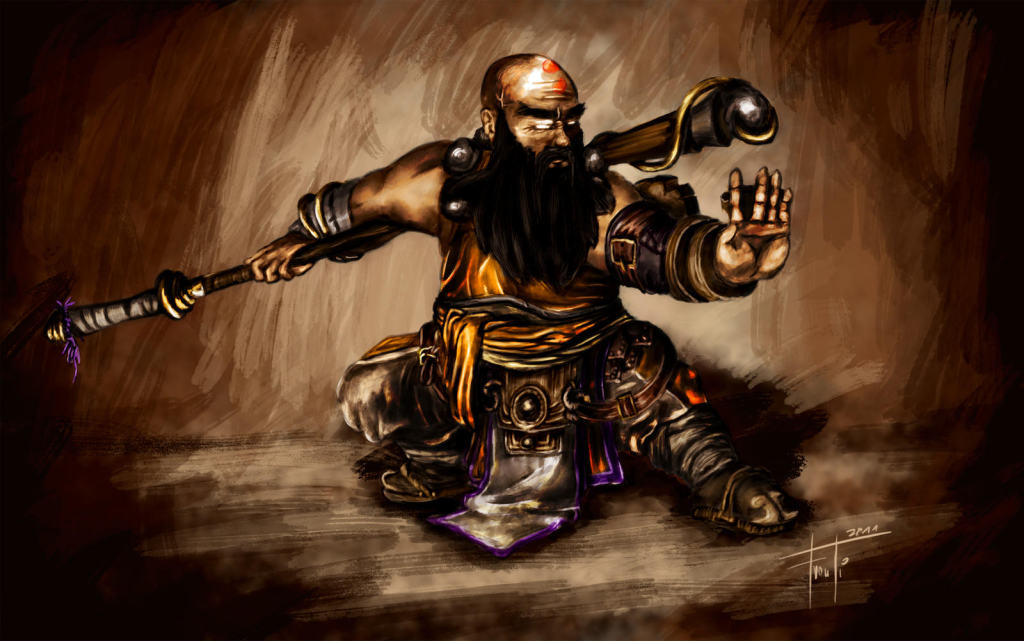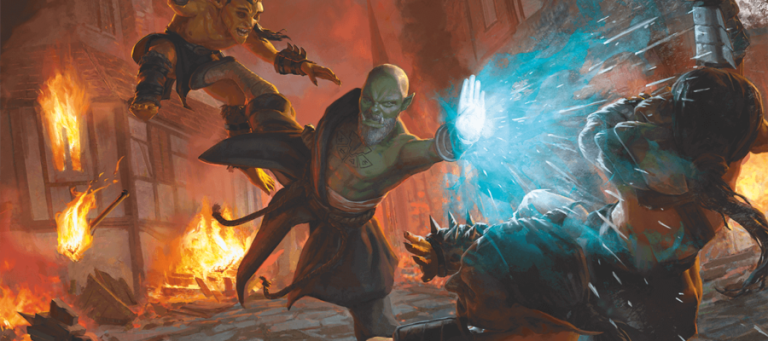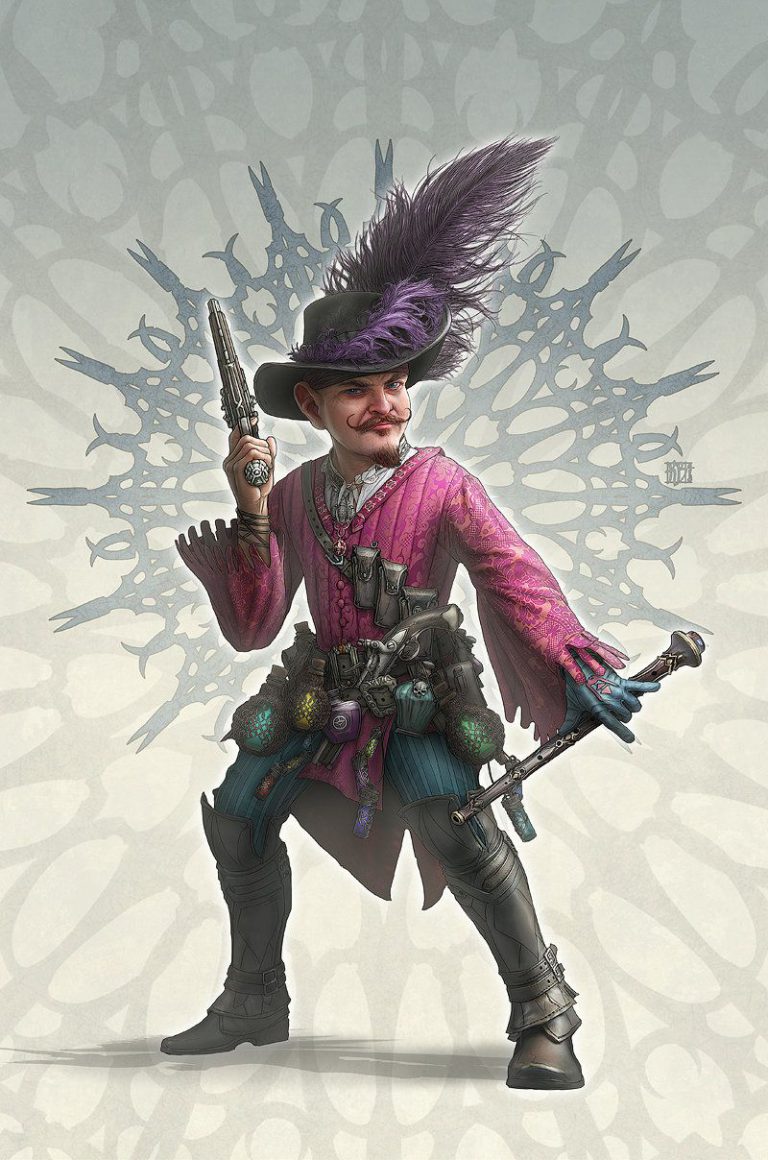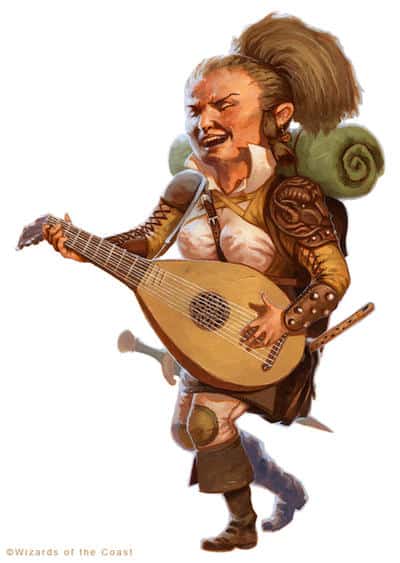D&D 5e: Dwarf Monk Guide

D&D 5e: Dwarf Monk Guide
As your ancestors to your parents and dwarven kin spend years perfecting their craft and weapons you’ve taken the same effort in building your mind, ki, and body. With fists full of fury you face your foes with a tranquil mind that strikes fear into your enemies!
The Dwarf race AND the Monk class can be found in the Player’s Handbook. Click here to pick up your own copy of The Player’s Handbook!
How to Make a Dwarf Monk
Short, bearded, greedy, conservative, traditionalists, family honor, clan that are good in crafting, love liquor, and hide in giant cities- compared to their height- underground best sums a dwarf’s existence. These bulky short humanoid beings are well known for their skills in crafting, forging, and defense. You better not be busy because there’s A LOT to unpack and mise-en-place if you’re planning to be this species of 4 to 5 feet short stacks.
There are a variety of dwarves to choose from too, each with a unique characteristic.The most common ones are:
*take note of their advantages
| Hill dwarves(Gold dwarves) | Particular, confident, materialistic,traditionalist- valuing themselves and others by possession and reputation- shrewd traders and proud stalwart warriors. These stocky and muscular dwarves are built and raised to fight the monsters of the Underdark. Appearance: Skin color: Light brown, tanHair: long & groomed, black, brown, gray. Usually gray to light gray with age.Eyes: Brown, hazelAdvantages: hit point maximum increases by 1, and it increases by 1 every time you gain a level. |
| Mountain dwarves(Shield dwarves) | Similar in build to the hills dwarves but broader, these so called cynical and gruff dwarves were once mighty rulers of Faerûn. Appearance: Skin color: Pale to lightly tannedHair: long & groomed, red to light brown but grays to white with age.Eyes: Green, silvery blueAdvantages: proficiency with light and medium armor. |
Then there are the latter known- but still relevant- dwarves:
| Arctic dwarves(Inugaakalikurit) | Strangely smaller- standing at half the height of shield dwarves- and more carefree, friendly, and even clumsy than other dwarves. They are said to be much stronger, resistant to extreme cold, but -despite their size- are less dextrous.Appearance: Skin color: White to icy blueHair: WhiteEyes: Bright blueAdvantages: immune to the extreme cold |
| Gray dwarves(Duergar/ underdwarves) | As opposed to their fellow dwarves, Duergars do not have a close family kinship and are cruel, deceitful, and bitter. They are the slaves that became slavers of the underground.Appearance: Skin color: Ash grayHair: Bald (both male and female) but have curly white beardsEyes: BlackAdvantages: Able to see clearly in the darkImmune to mind flayers control, such as paralysis, phantasms, alchemical poisons, or some types of illusion.Good at detecting hidden objects. A few duergar also possessed natural abilities akin to the enlarge and invisibility spells.Disadvantage: Vulnerable to Sunlight |
| Urdunnir dwarves(Urdunnirin/ orecutters) | Mysterious creations of Dumathion taken from shield dwarves of Shanatar. They live in the Underdark, eating gems, and are enemies of the Xorn. They are practically myths to other dwarven-kind. Appearance: Skin color: Stone grayHair: Groomed, stone grayEyes: SilverAdvantages: ability to walk through solid earth and stone at will, moving through normally solid materials.ability to shape stone and metal into any form then hardens when no longer in use. |
| Wild dwarves(Jungle dwarves/ greenbeards/ dur Authalar) | Stout, muscular, nude, and antisocial dwarves fearful of strangers and things unfamiliar to them (very relatable). Compared their cousins, Wild dwarves aren’t divided into clans but are polygamous and live as one family. Also, they keep wild cats (such as leopards and lynx) as pets and ride on triceratops!Appearance: Skin color: Dark & heavily tattooedHair: Long & WovenEyes: Dark brownAdvantages: Able to cast wild dwarven magic (usually involves nature spells and luck in hunting) |
If you’re taking the religious monk role, then you should note the following deities dwarves worship depending on type.
| Hill Dwarves | Deity: MoradinThe Allfather, creator, dwarf father, Soul forger and the big dog of the dwarven pantheon. Creator of all dwarves that encourages good natured, intelligent, and harmonious existence with other good races. Berronar TruesilverThe revered mother, mother of safety, and matriarch of the Morndinsamman. She is the goddess of life and light. Her clerics, the Faeron, acting as guardians to the dwarven clan and keepers of lore, traditions, and family histories of the dwarves Symbol: Hammer and Anvil (Moradin); Intertwined silver rings (Berronar)Alignment: Lawful GoodAlignment of dwarves: Lawful Good |
| Mountain Dwarves | Deity: *Previously they venerated Dumathoin (see Urdunnir dwarves) but now worship ALL members of Morndinsamman (dwarf pantheon) minus Laduguer and Deep Duerra.Alignment of dwarves: Lawful Neutral |
| Arctic Dwarves | Deity: (Not Religious)Symbol: NoneAlignment: NoneAlignment of dwarves: Lawful Neutral |
| Gray Dwarves | Deity: LaduguerThe gray protector, master of Crafts, and known as the Exile. Ultimately a xenophobic, tyrinnical deity, whos doctrine involves leadership and power obtained through the exploit and enslavement of others. Symbol: Broken arrowAlignment: Lawful EvilAlignment of dwarves: Lawful Evil |
| Urdunnir dwarves | Deity: DumathoinThe dwarven deity of mining, underground exploration, keeper of the secrets under the mountain, & protector of the dwarven dead. Symbol: A cut, faceted gem inside a mountainAlignment: NeutralAlignment of dwarves: Neutral |
| Wild dwarves | Deity: Thard HarrThe jungle god of dwarven pantheon that rules the jungles deep, jungle survival, and hunting. Symbol: Two clawed GauntletsAlignment: Chaotic GoodAlignment of dwarves: Lawful Neutral |
Way of the Monk: Charity, humility, and kick-ass
Being a monk does not mean you’ll be throat singing hymns your way into battle while slamming the philosophies of your religion on enemies -that’s a paladin’s job. This class is full of martial art masters that mostly focus on traditions and charity apart from spreading the word or theology of their denomination.
- Proficiencies:
- Armor: None
- Weapons: Simple weapons, shortswords
- Tools: Choose one type of artisan’s tools or one musical instrument
- Saving Throws: Strength, Dexterity
- Skills: Choose two from Acrobatics, Athletics, History, Insight, Religion, and Stealth
- Racial Advantage: Generally, dwarves get +2 in Constitution (dwarven fortitude) but you get more bonuses depending on subrace. Whenever you take the Dodge action in combat, you can spend one Hit Die to heal yourself. Such as:
- mountain dwarves get +2 Strength
- hill dwarves get +1 in wisdom.
Monastic Tradition– A feature granted on your 3rd level. These are subclasses for monks but instead of being different in religion, it’s more about differences in traditions.
- Way of the Open Hand– The ultimate martial arts master. Apart from butt-kicking skills you’re able to manipulate Ki, you’re able to heal damages on the body and keep your comrades from harm with meditation.
- Open hand technique
- Wholeness of body
- Tranquility
- Quivering Palm
- Way of the Shadow– Darkness! Shadows! Sneaking! Not a Rogue ripoff! These monks are better known as shadow dancers or ninjas, and work as assassins or spies for paying nobles. Their monasteries are more like a thieve’s guilds and expect total obedience from their members.
- Shadow arts
- Darkness
- Darkvision
- Pass without Trace
- Silence
- Shadow step
- Cloak of Shadows
- Shadow arts
- Way of the Four Elements– Mastering all elements and taking down the Fire Na- er- You get a super cool tattoo that represents your ki powers (animals, creatures, symbols, plants, landforms). This category focuses on being one and harnessing the elements, though some focus on just one.
- Disciple of the Elements
- Casting elemental spells
- Disciple of the Elements
- Elemental Disciplines
- Breath of Winter
- Clench of the North Wind
- Elemental Attunement
- Fangs of the Fire Snake
- Fist of the Four Thunders
- Fist of Unbroken Air
- Rush of the Gale Spirits
- Shape of the Flowing River
- Sweeping Cinder Strike
- Water Whip
- Clench of the North
- Gong of the Summit
- Flames of the Phoenix
- Ride the Wind
- Breath of Winter
- Eternal Mountain Defense
- River of Hungry Flame
- Wave of Rolling Earth
*the aforementioned are the ones in the 5e player handbook, but you don’t just want to settle for just those options, do you? You can ask your DM if they’ll let you choose something apart from the updated handbook.
- Way of Mercy– Manipulating lifeforce with the power of healing and harm at your fingertips. That doesn’t mean though you can bring the dead to life, kill someone instantly, or cure someone whose body was ripped in half. Still, it’s free healthcare.
- Implements of Mercy
- Hand of Healing
- Hand of Harm
- Physician’s touch
- Flurry of Healing and Harm
- Hand of Ultimate Mercy
- Way of the Astral Self– Being able to go ghost and throw hands. Just be careful with your Ki use and you’ll be able to work with this category with the flexibility of your tinder match who’s stopped contacting you for a week.
- Arms of the Astral Self
- Visage of the Astral Self
- Astral sight
- Wisdom of the Spirit
- Word of the Spirit
- Body of the Astral Self
- Deflect Energy
- Empowered Arms
- Awakened Astral Self
- Way of the Drunken Master– No, this isn’t some kind of “find enlightenment in a bottle”. This monastic tradition takes ‘drunken’ movements and a sober mind keeping the monk alive and out of direct attacks. Unfortunately, intoxicated frenzy is your only DIRECT offense.
- Bonus proficiencies
- Drunken Technique
- Tipsy Sway
- Leap to your feet
- Redirect Attack
- Drunkard’s luck
- Intoxicated frenzy
- Way of the Long Death– Basically buff monks on steroids that are hard to kill. They are practically Barbarians minus the rage and with fewer weapons; there are only fists and feet.
- Touch of Death
- Hour of Reaping
- Mastery of Death
- Touch of the Long Death
- Way of the Kensei– It’s a gamble to play in this category since it does grant you to use monastic weapons- even magical ones- and Agile Parry but you’ll have to wait until past level six for the boost to make much of a difference. Plus, access to strong magical weapons will depend on what your DM has laid out. Even then you’ll be spending more Ki left and right.
- Path of the Kensei
- Kensei weapons
- Agile Parry
- Kensei’s Shot
- Way of the Brush
- One with the Blade
- Magic Kensei Weapons
- Deft Strike
- Sharpen the Blade
- Unerring Accuracy
- Path of the Kensei
- Way of the Sun Soul– Through meditation and training the light in your soul shines out. Is there a way to be melee but with range? Yes, there is! Can you do it with little to no Ki? Absolutely! Will it give as much damage as Ki spending attacks? Not really….
- Radiant Sun Bolt
- Searing Arc Strike
- Searing Sunburst
- Sun Shield
- There are two good builds for a monk:
- If you’re into getting more points: Wisdom, Dexterity, Constitution, Intelligence, Strength, and finally Charisma.
- The standard: Dexterity, Constitution, Wisdom, Strength, Intelligence, then Charisma.
How to Play a Dwarf Monk
(In combat – Mechanically playing the character, notable class features, spells, etc.)
(https://aminoapps.com/c/officialdd/page/item/monk-class-features/Z6KQ_4aRtXIQ32zWb2YKm8V1qanKv1x67gM)
Hit Dice: 1d8 per monk level
Hit Points at 1st Level: 8 + your Constitution modifier
Hit Points at Higher Levels: 1d8 (or 5) + your Constitution modifier per monk level after 1st.
Ki save DC = 8 + your proficiency bonus + your Wisdom modifier
- Ki– is pretty much magical energy that flows through every creature and is harnessed by monks. If you’re a fan of a show about an irresponsible father whose existence is to collect magical dragon spheres, then the concept of power from energy is pretty similar. Over time with proper training, you won’t just be able to gain power but also bend that of others- low key bending.
| Monk Level | Max. Ki points for a Spell |
| 5th-8th | 3 |
| 9th-12th | 4 |
| 13th-16th | 5 |
| 17th-20th | 6 |
- Flurry of Blows. Immediately after you take the Attack action on your turn, you can spend 1 ki point to make two unarmed strikes as a bonus action.
- Patient Defense. You can spend 1 ki point to take the Dodge action as a bonus action on your turn.
- Step of the Wind. You can spend 1 ki point to take the Disengage or Dash action as a bonus action on your turn, and your jump distance is doubled for the turn.
Default features to being a monk:
- Unarmored Defense– You don’t need armor! Heck, going into battle might guarantee you more protection. After all who would want to go hand to hand against someone exposing their ‘jewels’. Your AC equals 10 + your Dexterity modifier + your Wisdom modifier.
- Martial Arts – You have training in one of the martial arts traditions of Kara-tur. You may take this feat multiple times to learn more techniques and gain 2 additional ki points. You may also spend downtime once you have taken this feat to learn a new technique. You gain the following benefits.
- You can use Dexterity instead of Strength for the Attack and Damage Rolls of your unarmed strikes, and you can roll a d4 in place of the normal damage of your Unarmed Strike. If you take this feat a second time you can roll a d6 in place of the normal damage of your Unarmed Strikes. You use this die for any techniques that reference your Martial Arts die.
- You learn two techniques of your choice from those available on the Martial Arts technique list. If a technique you use requires your target to make a saving throw to resist the technique’s effects, the saving throw DC equals 8 + your proficiency bonus + your Dexterity or Wisdom modifier (your choice).
- You gain 2 ki points. These are used to fuel your techniques. A ki point is expended when you use it. You regain all your expended ki points when you finish a short or long rest, as long as you spend 30 minutes of the rest meditating.
- Unarmored Movements- The longer and more exposed (less armor) you are the faster you go. Either that or everyone is just too shocked to move with your display of nudity.
- Monastic Tradition – When you reach 4th level, and again at 8th, 12th, 16th, and 19th level, you can increase one ability score of your choice by 2, or you can increase two ability scores of your choice by 1. As normal, you can’t increase an ability score above 20 using this feature.
- Deflect Missiles- Pulling the reverse uno card on ammunition and ranged weapons coming your way. When you do so, the damage you take from the attack is reduced by 1d 10 + your Dexterity modifier + your monk level.
- Ability score improvement
- Slow Fall – Beginning at 4th level, you can use your reaction when you fall to reduce any falling damage you take by an amount equal to five times your monk level. So no, you’re not actually slowly descending down upon mortals but rather taking less damage when you face-plant to the ground.
- Extra Attack– Beginning at 5th level, you can attack twice, instead of once, whenever you take the Attack action on your turn.
- Stunning Strike– You know that moment where something out of the blue stings or hurts in your body but nothing seems to be there to cause it. Yeah, you can cause that for your opponents.
- Ki-Empowered Strikes – Starting at 6th level, your unarmed strikes count as magical for the purpose of overcoming resistance and immunity to non magical attacks and damage.
- Evasion – At 7th level, your instinctive agility lets you dodge out of the way of certain area effects, such as a blue dragon’s lightning breath or a fireball spell. When you are subjected to an effect that allows you to make a Dexterity saving throw to take only half damage, you instead take no damage if you succeed on the saving throw, and only half damage if you fail.
- Stillness of Mind– Starting at 7th level, you can use your action to end one effect on yourself that is causing you to be charmed or frightened.
- Purity of Body– At 10th level, your mastery of the ki flowing through you makes you immune to disease and poison.
- Tongue of the Sun and Moon– Starting at 13th level, you learn to touch the ki of other minds so that you understand all spoken languages. Moreover, any creature that can understand a language can understand what you say. Basically, you’re multilingual and that comes in handy when you want to be more diplomatic in solving conflicts.
- Diamond Soul– Beginning at 14th level, your mastery of ki grants you proficiency in all saving throws. Additionally, whenever you make a saving throw and fail, you can spend 1 ki point to reroll it and take the second result.
- Timeless Body– At 15th level, you gain eternal youth. It’s not immortality but you look great for a 500-year-old. A big plus to it is you don’t need to eat or drink to live.
- Empty Body – Beginning at 18th level, you can use your action to spend 4 ki points to become invisible for 1 minute. During that time, you also have resistance to all damage but force damage.
- Additionally, you can spend 8 ki points to cast the Astral Projection spell, without needing material components. When you do so, you can’t take any other creatures with you.
- Perfect Self – At 20th level, when you roll for initiative and have no ki points remaining, you regain 4 ki points. Handy for long battles and needing to do attacks after a small rest.
How to Roleplay as a Dwarf Monk
(Outside of combat – Mindset for RPing, example backstory, accents, etc.)
For a dwarf to become a monk wouldn’t be far fetched. Your reason for becoming a monk can vary; it’s not always wanting to train mind and body, being taken in by a monastery since childhood, or a strong belief in a certain religion. It can be something serious as atonement, hiding for someone, renewing their life or something more comedic as losing a bet or being dared to. Similarly, the reason for your adventuring doesn’t always have to stick with “spreading the charity and mission of the monastery” or being on a mission, it can be something as dark as coming for vengeance or being kicked out of the monastery or light as wanting to visit your family or just a little trip.
As mentioned, dwarves live in a tight-knit community made up of clans. Unfortunately, due to their long life spans (400 years), you can end up living with generations of relatives and grandparents who have very traditionalist and conservative beliefs. They even value the achievements of their ancestors more and use them as their cause. Dwarves also find comfort in their religion and beliefs, often looking to their deities for inspiration.
Although this can vary from where and what kind of dwarf they are. The best examples are Arctic dwarves. These dwarves are like that side of the family that no one wants to talk about and even denies their existence until you meet them in a family reunion. They are more friendly and open to other races as opposed to their conservative relatives. They are more suitable as rangers and barbarians, but it is up to you.
Then there’s the Duergar, the slave masters of the underground that once were slaves to an eldritch god. Compared to their honor-abiding-mostly-lawful-good cousins, they are deceitful, crafty, bitter, distrustful, and pretty much the opposite of anything wholesome. From a young age, they are taught that family, love, and kinship are hurdles, and there are only two things that one may choose in life: To work or die, the first you may be useful, the second you are entertainment. Additionally, they have a strong tradition of magic compared to their cousins.
Dwarves are able to read, write, and speak common and dwarvish/dwarven. Dwarves call their language Dethek but other races use this word to refer to the dwarven alphabet). It is composed of various dialects such as Authalan (Wild dwarves), Duergan ( influenced by drow & illithid; Shield dwarves), Galena (Eastern shield dwarves), Kurit (Arctic dwarves), Riftspeak (Gold dwarves), & Shanatan (Western shield dwarves).
Racial and Class relationships:
Dwarves tend to have a say or “basic description” for each race regardless of individuality. They find some acceptable and even ‘cute’ races such as gnomes (whom they may regard as cousins), half-elves, & halflings. For some, they may tolerate with caution, such as elves- whom they find strange-, half-orcs, genasis, aasimars, tieflings, and giants (there is some bad blood and history between giants and dwarves, but some of it has been forgotten, dwarves are still wary of them). What’s more dwarves are slow to trust and can bear a grudge, new and old, for a lifetime. Although they’re very patient, if you ever cross one, get off your high horse, bring a precious gift, and apologize!
Speaking of grudges, dwarves DO NOT mingle well with orcs and goblins due to a long history of slavery, genocide, and colonialism. Orcs have taken a liking to how dwarves build their homes and their craft while goblins are in it for the hidden treasure. Even for a clan that has been liberated for hundreds of years, their hatred would be taught to the next generation and the next as a precaution. Again, this also depends on what kind of dwarf you may be and the environment you grow up in.
When it comes to ties with humans, dwarves find a bittersweetness to how short their mortality is. According to some accounts in handbook 5e, by the time a dwarf finally gets to know a human deeply, the human is already on their deathbed. The dwarf can only look forward to getting to know that human more through children/grandchildren/family members that hopefully have the same good heart as their friend. Regardless, Dwarven friendship and trust is hard to earn but when it is earned, it can last past lifetimes through generations.









